
Property, Power and the Growth of Towns
Routledge (Verlag)
978-1-032-00094-7 (ISBN)
- Lieferbar (Termin unbekannt)
- Versandkostenfrei innerhalb Deutschlands
- Auch auf Rechnung
- Verfügbarkeit in der Filiale vor Ort prüfen
- Artikel merken
Local enterprise, institutional quality and strategic location were of central importance in the growth of medieval towns. This book, comprising a study of 112 English towns, emphasises these key factors. Downstream locations on major rivers attracted international trade, and thereby stimulated the local processing of imports and exports, while the early establishment of richly endowed religious institutions funnelled agricultural rental income into a town, where it was spent on luxury goods produced by local craftsmen and artisans, and on expensive, long-running building schemes. Local entrepreneurs who recognised the economic potential of a town developed residential suburbs which attracted wealthy residents. Meanwhile town authorities invested in the building and maintenance of bridges, gates, walls and ditches, often with financial support from wealthy residents. Royal lordship was also an advantage to a town, as it gave the town authorities direct access to the king and bypassed local power-brokers such as bishops and earls.
The legacy of medieval investment remains visible today in the streets of important towns. Drawing on rentals, deeds and surveys, this book also examines in detail the topography of seven key medieval towns: Bristol, Gloucester, Coventry, Cambridge, Birmingham, Shrewsbury and Hull. In each case, surviving records identify the location and value of urban properties, and their owners and tenants. Using statistical techniques, previously applied only to the early modern and modern periods, the book analyses the impact of location and type of property on property values. It shows that features of the modern property market, including spatial autocorrelation, were present in the middle ages. Property hot-spots of high rents are also identified; the most valuable properties were those situated between the market and other focal points such transport hubs and religious centres, convenient for both, but remote from noise and pollution.
This book takes an interdisciplinary approach, drawing on expertise from the disciplines of economics and history. It will be of interest to historians and to social scientists looking for a long-run perspective on urban development.
Catherine Casson is Senior Lecturer in Enterprise at Alliance Manchester Business School, University of Manchester. Her publications include articles in Urban History, Business History Review, Business History and the Economic History Review and the co-authored book Compassionate Capitalism: Business and Community in Medieval England (2020). Mark Casson is Professor of Economics at the University of Reading and Director of the Centre for Institutions and Economic History. He has published in Economic History Review, Explorations in Economic History, Business History Review. He is the co-author (with Catherine Casson) of The Entrepreneur in History (2013).
Chapter 1 Introduction Chapter 2 Town comparisons: Southern England Part 1 Chapter 3 Town comparisons: Southern England Part 2 Chapter 4 Town comparisons: Midlands and North England Chapter 5 Explaining the growth of towns 1086-1524: a statistical analysis of 112 towns Chapter 6: Town growth and topography Chapter 7: Conclusion
| Erscheinungsdatum | 17.05.2023 |
|---|---|
| Reihe/Serie | Routledge Explorations in Economic History |
| Zusatzinfo | 42 Tables, black and white; 7 Halftones, black and white; 7 Illustrations, black and white |
| Verlagsort | London |
| Sprache | englisch |
| Maße | 156 x 234 mm |
| Gewicht | 570 g |
| Themenwelt | Geschichte ► Allgemeine Geschichte ► Mittelalter |
| Geschichte ► Teilgebiete der Geschichte ► Wirtschaftsgeschichte | |
| Sozialwissenschaften ► Soziologie | |
| Wirtschaft ► Volkswirtschaftslehre ► Mikroökonomie | |
| ISBN-10 | 1-032-00094-5 / 1032000945 |
| ISBN-13 | 978-1-032-00094-7 / 9781032000947 |
| Zustand | Neuware |
| Haben Sie eine Frage zum Produkt? |
aus dem Bereich


